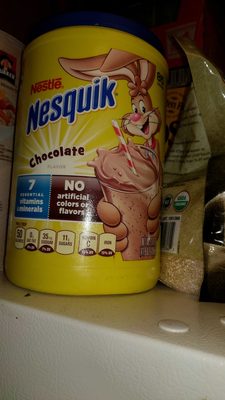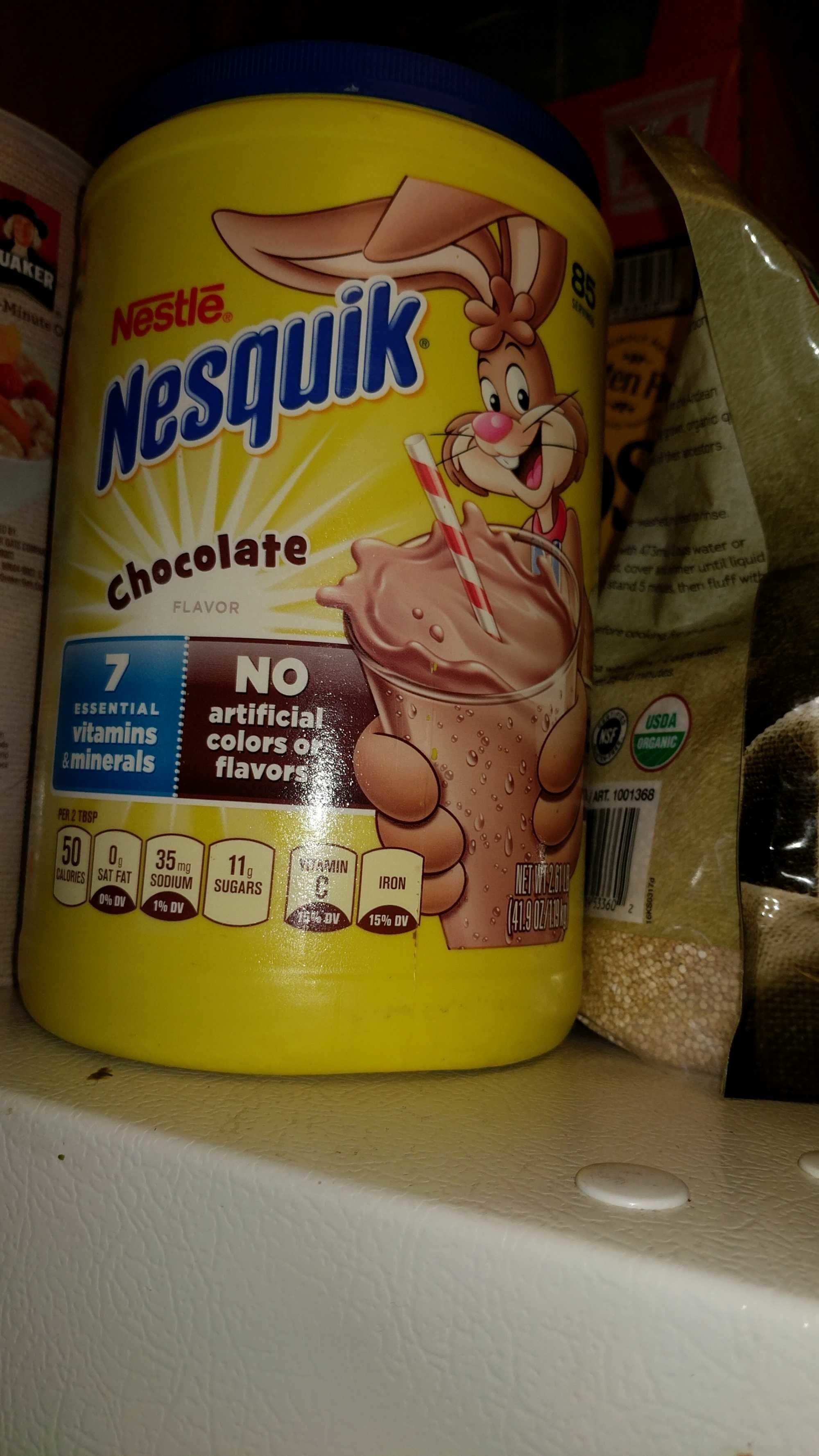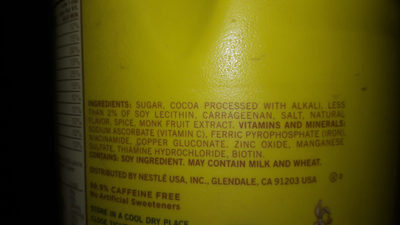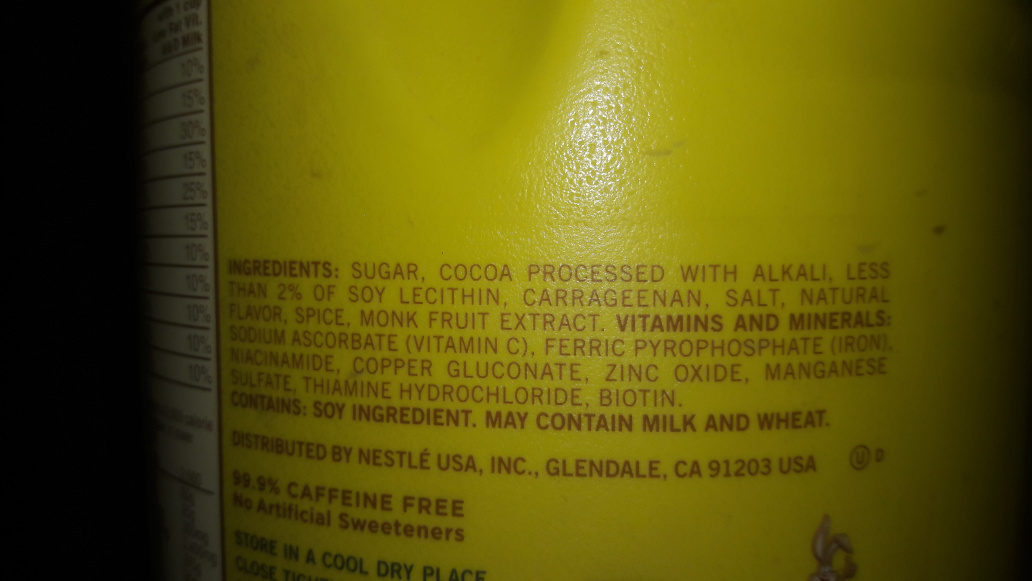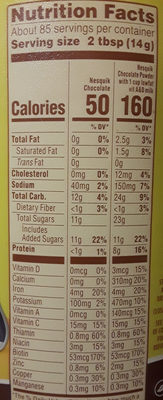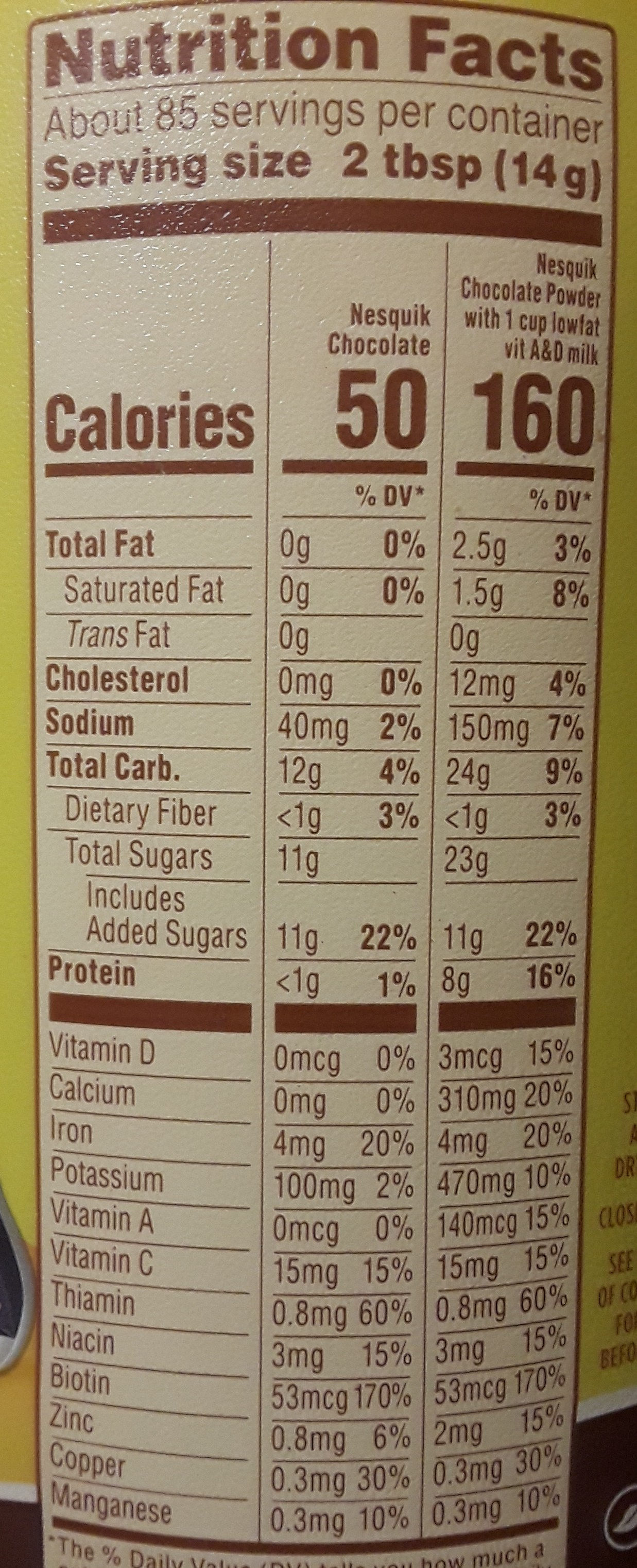Help us make food transparency the norm!
As a non-profit organization, we depend on your donations to continue informing consumers around the world about what they eat.
The food revolution starts with you!
Chocolate flavored milk powder - Nesquik - 1.18kg
Chocolate flavored milk powder - Nesquik - 1.18kg
This product page is not complete. You can help to complete it by editing it and adding more data from the photos we have, or by taking more photos using the app for Android or iPhone/iPad. Thank you!
×
Barcode: 0028000463687 (EAN / EAN-13) 028000463687 (UPC / UPC-A)
Quantity: 1.18kg
Packaging: Hdpe-bottle
Brands: Nesquik
Brand owner: Nestle USA Inc.
Categories: Beverages, Breakfasts, Cocoa and its products, Dried products, Dried products to be rehydrated, Cocoa and chocolate powders, Instant beverages, Dehydrated beverages, Chocolate powders
Labels, certifications, awards: No artificial flavors, No-vegan
Countries where sold: Panama, United States
Matching with your preferences
Health
Ingredients
-
21 ingredients
Sugar, cocoa processed with alkali, less than 2% of: soy lecithin, carrageenan, salt, natural flavor, spice, monk fruit extract, vitamins and minerals: sodium ascorbate (vitamin c), ferric pyrophosphate (iron), niacinamide, copper gluconate, zinc oxide, manganese sulfate, thiamine hydrochloride, biotin.Allergens: Soybeans
Food processing
-
Ultra processed foods
Elements that indicate the product is in the 4 - Ultra processed food and drink products group:
- Additive: E322 - Lecithins
- Additive: E407 - Carrageenan
- Additive: E450 - Diphosphates
- Ingredient: Flavouring
Food products are classified into 4 groups according to their degree of processing:
- Unprocessed or minimally processed foods
- Processed culinary ingredients
- Processed foods
- Ultra processed foods
The determination of the group is based on the category of the product and on the ingredients it contains.
Additives
-
E322 - Lecithins
Lecithins are natural compounds commonly used in the food industry as emulsifiers and stabilizers.
Extracted from sources like soybeans and eggs, lecithins consist of phospholipids that enhance the mixing of oil and water, ensuring smooth textures in various products like chocolates, dressings, and baked goods.
They do not present any known health risks.
-
E322i - Lecithin
Lecithins are natural compounds commonly used in the food industry as emulsifiers and stabilizers.
Extracted from sources like soybeans and eggs, lecithins consist of phospholipids that enhance the mixing of oil and water, ensuring smooth textures in various products like chocolates, dressings, and baked goods.
They do not present any known health risks.
-
E407 - Carrageenan
Carrageenan (E407), derived from red seaweed, is widely employed in the food industry as a gelling, thickening, and stabilizing agent, notably in dairy and meat products.
It can exist in various forms, each imparting distinct textural properties to food.
However, its degraded form, often referred to as poligeenan, has raised health concerns due to its potential inflammatory effects and its classification as a possible human carcinogen (Group 2B) by the International Agency for Research on Cancer (IARC).
Nevertheless, food-grade carrageenan has been deemed safe by various regulatory bodies when consumed in amounts typically found in food.
-
E450 - Diphosphates
Diphosphates (E450) are food additives often utilized to modify the texture of products, acting as leavening agents in baking and preventing the coagulation of canned food.
These salts can stabilize whipped cream and are also found in powdered products to maintain their flow properties. They are commonly present in baked goods, processed meats, and soft drinks.
Derived from phosphoric acid, they're part of our daily phosphate intake, which often surpasses recommended levels due to the prevalence of phosphates in processed foods and drinks.
Excessive phosphate consumption is linked to health issues, such as impaired kidney function and weakened bone health. Though diphosphates are generally regarded as safe when consumed within established acceptable daily intakes, it's imperative to monitor overall phosphate consumption to maintain optimal health.
Ingredients analysis
-
Palm oil free
No ingredients containing palm oil detected
Unrecognized ingredients: Less-than-2-of, Monk-fruit-extractSome ingredients could not be recognized.
We need your help!
You can help us recognize more ingredients and better analyze the list of ingredients for this product and others:
- Edit this product page to correct spelling mistakes in the ingredients list, and/or to remove ingredients in other languages and sentences that are not related to the ingredients.
- Add new entries, synonyms or translations to our multilingual lists of ingredients, ingredient processing methods, and labels.
If you would like to help, join the #ingredients channel on our Slack discussion space and/or learn about ingredients analysis on our wiki. Thank you!
-
Vegan status unknown
Unrecognized ingredients: Less-than-2-of, Monk-fruit-extract, Vitamin C, Ferric diphosphate, Iron, Copper gluconate, Zinc oxide, Manganese sulfate, Thiamin hydrochlorideSome ingredients could not be recognized.
We need your help!
You can help us recognize more ingredients and better analyze the list of ingredients for this product and others:
- Edit this product page to correct spelling mistakes in the ingredients list, and/or to remove ingredients in other languages and sentences that are not related to the ingredients.
- Add new entries, synonyms or translations to our multilingual lists of ingredients, ingredient processing methods, and labels.
If you would like to help, join the #ingredients channel on our Slack discussion space and/or learn about ingredients analysis on our wiki. Thank you!
-
Vegetarian status unknown
Unrecognized ingredients: Less-than-2-of, Monk-fruit-extract, Vitamin C, Ferric diphosphate, Iron, Copper gluconate, Zinc oxide, Manganese sulfate, Thiamin hydrochlorideSome ingredients could not be recognized.
We need your help!
You can help us recognize more ingredients and better analyze the list of ingredients for this product and others:
- Edit this product page to correct spelling mistakes in the ingredients list, and/or to remove ingredients in other languages and sentences that are not related to the ingredients.
- Add new entries, synonyms or translations to our multilingual lists of ingredients, ingredient processing methods, and labels.
If you would like to help, join the #ingredients channel on our Slack discussion space and/or learn about ingredients analysis on our wiki. Thank you!
-
Details of the analysis of the ingredients
We need your help!
Some ingredients could not be recognized.
We need your help!
You can help us recognize more ingredients and better analyze the list of ingredients for this product and others:
- Edit this product page to correct spelling mistakes in the ingredients list, and/or to remove ingredients in other languages and sentences that are not related to the ingredients.
- Add new entries, synonyms or translations to our multilingual lists of ingredients, ingredient processing methods, and labels.
If you would like to help, join the #ingredients channel on our Slack discussion space and/or learn about ingredients analysis on our wiki. Thank you!
: Sugar, cocoa processed with alkali, less than 2% of (soy lecithin), carrageenan, salt, natural flavor, spice, monk fruit extract, vitamins, minerals (sodium ascorbate (vitamin c)), ferric pyrophosphate (iron), niacinamide, copper gluconate, zinc oxide, manganese sulfate, thiamine hydrochloride, biotin- Sugar -> en:sugar - vegan: yes - vegetarian: yes - ciqual_proxy_food_code: 31016 - percent_min: 5.88235294117647 - percent_max: 100
- cocoa processed with alkali -> en:cocoa-processed-with-alkali - vegan: yes - vegetarian: yes - ciqual_proxy_food_code: 18100 - percent_min: 0 - percent_max: 50
- less than 2% of -> en:less-than-2-of - percent_min: 0 - percent_max: 33.3333333333333
- soy lecithin -> en:soya-lecithin - vegan: yes - vegetarian: yes - ciqual_food_code: 42200 - percent_min: 0 - percent_max: 33.3333333333333
- carrageenan -> en:e407 - vegan: yes - vegetarian: yes - percent_min: 0 - percent_max: 25
- salt -> en:salt - vegan: yes - vegetarian: yes - ciqual_food_code: 11058 - percent_min: 0 - percent_max: 0.625
- natural flavor -> en:natural-flavouring - vegan: maybe - vegetarian: maybe - percent_min: 0 - percent_max: 0.625
- spice -> en:spice - vegan: yes - vegetarian: yes - percent_min: 0 - percent_max: 0.625
- monk fruit extract -> en:monk-fruit-extract - percent_min: 0 - percent_max: 0.625
- vitamins -> en:vitamins - vegan: yes - vegetarian: yes - percent_min: 0 - percent_max: 0.625
- minerals -> en:minerals - percent_min: 0 - percent_max: 0.625
- sodium ascorbate -> en:e301 - vegan: yes - vegetarian: yes - percent_min: 0 - percent_max: 0.625
- vitamin c -> en:vitamin-c - percent_min: 0 - percent_max: 0.625
- sodium ascorbate -> en:e301 - vegan: yes - vegetarian: yes - percent_min: 0 - percent_max: 0.625
- ferric pyrophosphate -> en:ferric-diphosphate - percent_min: 0 - percent_max: 0.625
- iron -> en:iron - percent_min: 0 - percent_max: 0.625
- niacinamide -> en:e375 - vegan: maybe - vegetarian: maybe - percent_min: 0 - percent_max: 0.625
- copper gluconate -> en:copper-gluconate - percent_min: 0 - percent_max: 0.625
- zinc oxide -> en:zinc-oxide - percent_min: 0 - percent_max: 0.625
- manganese sulfate -> en:manganese-sulfate - percent_min: 0 - percent_max: 0.625
- thiamine hydrochloride -> en:thiamin-hydrochloride - percent_min: 0 - percent_max: 0.625
- biotin -> en:biotin - vegan: yes - vegetarian: yes - percent_min: 0 - percent_max: 0.625
-
Nutrition facts
Nutrition facts As sold
for 100 g / 100 mlAs sold
per serving (2g)Compared to: Chocolate powders Energy 1,494 kj
(357 kcal)29.9 kj
(7 kcal)+1% Fat 0 g 0 g -100% Saturated fat 0 g 0 g -100% Trans fat 0 g 0 g Cholesterol 0 mg 0 mg Salt 0.625 g 0.012 g +57% Carbohydrates 85.71 g 1.71 g +32% Fiber 7.1 g 0.142 g +32% Sugars 78.57 g 1.57 g +54% Proteins 7.14 g 0.143 g +32% Vitamin A 0 µg 0 µg Vitamin C (ascorbic acid) 107.1 mg 2.14 mg Vitamin B1 (Thiamin) 6 mg 0.12 mg Vitamin B3/PP (Niacin) 21.429 mg 0.429 mg Biotin 379 µg 7.58 µg Calcium 0 mg 0 mg -100% Iron 28.57 mg 0.571 mg +214% Potassium 714 mg 14.3 mg Zinc 5.71 mg 0.114 mg Copper 2.143 mg 0.043 mg Manganese 2 mg 0.04 mg Fruits‚ vegetables‚ nuts and rapeseed‚ walnut and olive oils (estimate from ingredients list analysis) 0 % 0 %
Environment
-
Eco-Score C - Moderate environmental impact
The Eco-Score is an experimental score that summarizes the environmental impacts of food products.→ The Eco-Score was initially developped for France and it is being extended to other European countries. The Eco-Score formula is subject to change as it is regularly improved to make it more precise and better suited to each country.Life cycle analysis
-
Average impact of products of the same category: C (Score: 54/100)
Category: Instant cocoa or chocolate beverage, with sugar, ready-to-drink (reconstituted with standard semi-skimmed milk)
- PEF environmental score: 0.14 (the lower the score, the lower the impact)
- including impact on climate change: 1.48 kg CO2 eq/kg of product
Stage Impact Agriculture
65.5 %Processing
5.2 %Packaging
11.4 %Transportation
11.6 %Distribution
3.4 %Consumption
3.0 %
Bonuses and maluses
-
Missing origins of ingredients information
Malus: -5
⚠ ️ The origins of the ingredients of this product are not indicated.
If they are indicated on the packaging, you can modify the product sheet and add them.
If you are the manufacturer of this product, you can send us the information with our free platform for producers.
-
Packaging with a medium impact
Malus: -5
Shape Material Recycling Impact Bottle HDPE 2 - High-density polyethylene Medium
Eco-Score for this product
-
Impact for this product: C (Score: 44/100)
Product: Chocolate flavored milk powder - Nesquik - 1.18kg
Life cycle analysis score: 54
Sum of bonuses and maluses: -10
Final score: 44/100
-
Carbon footprint
-
Equal to driving 0.8 km in a petrol car
148 g CO² per 100g of product
The carbon emission figure comes from ADEME's Agribalyse database, for the category: Instant cocoa or chocolate beverage, with sugar, ready-to-drink (reconstituted with standard semi-skimmed milk) (Source: ADEME Agribalyse Database)
Stage Impact Agriculture
64.8 %Processing
7.2 %Packaging
12.5 %Transportation
13.6 %Distribution
1.1 %Consumption
0.7 %
Packaging
-
Packaging with a medium impact
-
Packaging parts
Bottle (HDPE 2 - High-density polyethylene)
-
Packaging materials
Material % Packaging weight Packaging weight per 100 g of product Plastic
-
Transportation
-
Origins of ingredients
Missing origins of ingredients information
⚠ ️ The origins of the ingredients of this product are not indicated.
If they are indicated on the packaging, you can modify the product sheet and add them.
If you are the manufacturer of this product, you can send us the information with our free platform for producers.Add the origins of ingredients for this product Add the origins of ingredients for this product
Report a problem
-
Incomplete or incorrect information?
Category, labels, ingredients, allergens, nutritional information, photos etc.
If the information does not match the information on the packaging, please complete or correct it. Open Food Facts is a collaborative database, and every contribution is useful for all.
Data sources
Product added on by openfoodfacts-contributors
Last edit of product page on by liss14.
Product page also edited by diegomoran, kiliweb, nestle-france, nobodywasishere, org-database-usda, roboto-app, swipe-studio, teolemon, veganeamos, yuka.WTQ0QUFhOGYvcUlKdVBNNnBRejI0ZklyekpXcGQxUG9KTkFmSVE9PQ.
